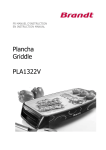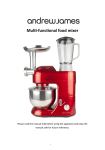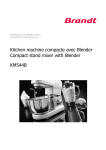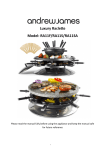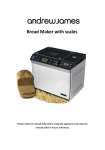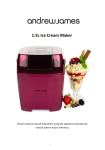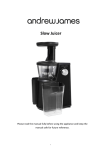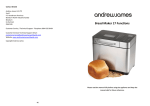Download Multifunctional Processor
Transcript
Multifunctional Processor Please read the manual fully before using the appliance and keep the manual safe for future reference. 1 Contents page General safeguards Page 3 Appliance components diagram Page 5 Attachments parts list Page 6 Use Knife blade/ dough tool Page 6-7 Slicing/ rasping/ shredding disc Page 8 Twin beater whisk attachment Page 9 Mill Page 10 Liquidizer Page 11 Citrus press Page 12 Centrifugal juicer Page 13 Mini processor bowl Page 14 Recipes Page 15—24 Cleaning Page 25 Disposal of the appliance Page 25 UK & EU Guarantee Page 26 Electrical information Page 27 Contact details Page 28 2 General safeguards When using any electrical appliance, basic safety precautions should always be followed including: This appliance can be used by children aged from 8 years and above and persons with reduced physical, sensory or mental capabilities or lack of experience and knowledge if they have been given supervision or instruction concerning use of the appliance in a safe way and understand the hazards involved. Children shall not play with the appliance. Cleaning and user maintenance shall not be made by children unless they are older than 8 and supervised. Keep the appliance and its cord out of reach of children less than 8 years old. Always ensure the voltage on the rating label corresponds to the voltage in your home. Check the power cord and plug regularly for any damage. If the cord or the plug is damaged, it must be replaced by a qualified electrician or a service repair centre. If in doubt please contact our customer service team. The appliance is intended for domestic use only. Industrial or commercial use will void the warranty. The supplier cannot be held responsible for injury or damage if the appliance has been used for anything other than its intended use. Incorrect operation and use can damage the appliance and cause injury to the user. Do not use the appliance if it has been dropped or damaged in any way. If the unit has been damaged take the unit for examination and or repair by an authorised service agent. Do not immerse or expose the motor assembly, plug or the power cord in water or any other liquid for any reason. If the supply cord is damaged, it must be replaced by the manufacturer or by someone who is suitably qualified to avoid a potential hazard. Do not let the cord hang over the edge of a table or counter. Ensure that the cord is not in a position where it can be pulled or tripped over accidentally. Do not allow the cord to touch hot surfaces and do not place the cord near hot gas, electric burners or in a heated oven. Use of an extension cord with this appliance is not recommended. However if it is necessary to use an extension cord, ensure that the extension cord is equal to or greater than the power consumption of the appliance to avoid overheating of the appliance and extension cord. Do not use any other appliance on the extension cord. Do not place the extension cord in a position where it can be pulled on by children or animals or be tripped over. Always operate the appliance on a smooth, even and stable surface. Do not 3 place the unit on a hot surface. Always remove the plug of the appliance safely. Do not pull on the appliances cord to remove the appliance plug from the electrical socket. Never handle or operate the appliance with wet hands. Appliance specific Safeguards Always unplug the appliance before attempting to reach into the blender jar with your fingers or an object (e.g. a spatula). Avoid contact with moving parts and fitted attachments during operation. In order to reduce the risk of injury to persons and/or damage to the mixer, always keep hands, hair, clothing, spatulas and other utensils away from moving parts during operation. Always switch off the appliance before turning the control knob to 0. Switch off the appliance at the mains before you attach or detach any accessories. Never immerse the motor unit in water or any other liquid for any reason. Never use your fingers or an object (e.g. spatula) to push ingredients down the feed tube while the appliance is running. Wait until moving parts stop before you remove the lid of the bowl or jar. Do not exceed the maximum content indicated on the bowl or the blender jar. DO NOT PUT HOT LIQUIDS INTO THE LIQUIDISER AS THIS WILL CAUSE THE APPLIANCES JUG TO CRACK. THE TEMPERATURE OF FOODS ADDED TO THE LIQUIDISER SHOULD NOT EXCEED 60°C ABOVE THE TEMPERATURE OF THE ROOM. Allow the jug to warm up to room temperature before adding warm liquids. 4 Appliance components diagram Food pusher (1) Feeder (7) Bowl cover (2) 1.5L bowl (3) Handle (8) Drive shaft (4) Dough tool (9) Power unit (5) Speed switch (6) 5 Attachment parts list Centrifugal juicer and lid (10 & 11) Grinder with lid (12) 0.5 litre bowl (18) S/S Knife blade (16) Spatula (17) Small knife blade (19) Twin beater whisk (13) Citrus press (14 & 15) S/S Shred disc (20) 1.5L glass jar (24) S/S Julienne disc (21) S/S rough slicer and julienne disc (22) S/S Fine slicer and julienne disc (23) Knife Blade/Dough Tool The knife blade is the most versatile of all the attachments. The length of the processing time will determine the texture achieved, for coarser textures use the pulse control. Use the knife blade for cake and pastry making, chopping raw and cooked meat, vegetables, nuts, pate, dips, pureeing soups and also to make crumbs from biscuits and bread. It can also be used for yeasted dough mixes. To ensure the long life of your machine, do not use the appliance continuously for more than 3 minutes on this function. The motor should be allowed to cool down for at least 1 minute, between each use. Use for no more than 3 times without allowing the machine to cool down fully. 6 Knife Blade/ Dough Tool Assembly 1. Place drive shaft (4) into the centre of the power unit (5). Ensure it is firmly in place. 2. Guide the 1.5L mixing bowl (3) over the drive shaft (4) and align with the locking system. Turn the bowl clockwise until it is locked firmly in place. 3. Place the blade (16) over the drive shaft (4) until it reaches the base of the bowl. 4. Place the bowl cover (2) on the 1.5L bowl (3), aligning it with the locking system. Turn the bowl cover clockwise until the lid locks into place at the top of the handle. Please note: Due to a safety locking system the food processor will not work until the components are locked in place correctly. Disassembly 1. Unlock the bowl cover (2) by turning it anti-clockwise and remove the knife blade (16). 2. Turn the bowl (3) anti-clockwise until it comes free of the locking system. 7 Slicing/ Rasping/ Shredding discs Use the slicing disc for cheese, carrots, potatoes and foods of a similar texture. Use the shredding disc for cheese, carrots, potatoes and foods of a similar texture. Use the rasping disc to grate parmesan cheese or foods where a fine grate is required. Do not use this function for more than 3 minutes at a time. The motor should be allowed to cool down for at least 30 minutes before the next operation. Assembly 1. Place the bowl (3) onto the driver shaft (4) and lock it into place. 2. Place the shredding disc (20) onto the driver shaft (4). Please note: the disc will sit at the lip of the shaft. 3. Place the bowl cover (2) on the 1.5L bowl (3) aligning it with the locking system. Turn the bowl cover anti-clockwise until the lid locks into place at the top of the handle. 4. Turn the food processor on and guide the vegetable/ fruit through the feeder (7) with the food pusher (1). 5. When there is no food left to be grated/sliced, turn the food processor off. 8 Twin beater whisk attachment Use for light mixtures only e.g. egg whites, cream, evaporated milk and for whisking eggs and sugar for fatless sponges. Heavier mixtures such as fat and flour will damage the attachments if used. To ensure the long life of your machine, do not use continuously for more than 3 minutes on this function. The motor should be allowed to cool down for at least 30 minutes before the next operation. Assembly 1. Place the drive shaft (4) on to the power unit (5). 2. Put the 1.5L Bowl (3) onto the drive shaft (4) rotating clockwise until it fits into the power unit (5). 3. Clip the whisks into the whisk attachment (13) by inserting the two prongs into the cross-shaped slots. 4. Place the food you wish to whisk into the 1.5l bowl (3) 5. Attach the whisk attachment (13) to the drive shaft (4) firmly applying pressure to ensure it is correctly fixed. 6. Place the bowl cover (2) on to the top of the 1.5L jug (3) by placing it inside the bowl and aligning the lid of the cover with the handle of the jug. 7. It is recommended to start the speed setting on low then increase the speed setting. Disassembly 1. Switch off the appliance. 2. Remove the bowl cover (2) by clasping the feed and rotating the bowl cover clockwise to unlock it from the bowl (3). 3. Unlock the bowl (3) from the power unit (5) by rotating it clockwise using the handle. 4. Empty out ingredients. 5. Remove the drive shaft (4) and clean the appliance as instructed in the cleaning section of the manual. 9 Mill function (refer to manual) Use the mill function for milling herbs, nuts and coffee beans. To ensure the long life of your machine, do not use the machine continuously for more than 1 minute at a time. The motor should be allowed to cool down for at least 30 minutes before the next operation. Assembly 1. Place your ingredients into the grinder (12) and attach the grinder blade ensuring that it Is securely fitted (a locked symbol will appear on the grinder). 2. Place the grinder (12) onto the power unit (5) cross axis and rotate it until a clicking sound can be heard, this confirms it is correctly assembled. 3. Turn the speed knob on the power unit to the required setting. Disassembly 1. Switch off the appliance. 2. Rotate the grinder (12) anti-clockwise until an unlocked symbol can be seen on the grinder and remove it from the power unit (5). 3. Turn the grinder upside down so that the grinder blade is facing upwards and remove the grinder blade. 4. Remove the blade by rotating it anti-clockwise, empty out the ingredients or place the lid on the grinder to sprinkle ingredients. 5. Wash them accordingly. 10 Liquidiser Use the liquidiser function for pasta sauces, soups, milkshakes etc. Do not use the machine continuously for more than 30 seconds on this function. The motor should be allowed to cool down for at least 1 minute. Only use for a maximum of 3 times before letting the machine cool down fully. DO NOT PUT HOT LIQUIDS INTO THE LIQUIDISER AS THIS WILL CAUSE THE APPLIANCES JUG TO CRACK. THE TEMPERATURE OF FOODS ADDED TO THE LIQUIDISER SHOULD NOT EXCEED 60°C ABOVE THE TEMPERATURE OF THE ROOM. Allow the jug to warm up to room temperature before adding warm liquids. Assembly 1. The glass jar (24) already comes fully assembled. The bottom is not removable. Attach it to the power unit (5) by rotating it clockwise. 2. Remove the lid, place in the ingredients and place the lid back on the jar. 3. Turn the speed dial to the required setting. Disassembly 1. Remove the glass jar (24) by rotating the jug anti-clockwise using the handle. 1. Lift the lid off the appliance and pour out the ingredients. 2. Clean as instructed. 11 Citrus press Assemble the appliance according to the diagram Use the citrus press to squeeze the juice from citrus fruits (e.g. oranges, lemons, limes and grapefruits). To ensure the long life of your machine, do not use it continuously for more than 3 minutes on this function. Only use for a maximum of 3 times before letting the machine cool down fully. The motor should be allowed to cool down for at least 30 minutes before the next operation. Assembly 1. Attach the drive shaft (4) to the power unit (5) and place the 1.5l bowl (3) onto the power unit rotating clockwise until it clicks into place. 2. Place the citrus press (14) on top of the 1.5L bowl (3) so that the lip of the citrus press can fit into the bowl (3). Rotate it clockwise until it clicks into position. 3. Place the citrus press attachment (15) into the centre of the citrus press (14). 4. Place the cut fruit onto the citrus press attachment (15) and press down. 5. Turn the speed setting to a minimum setting and increase if necessary. Disassembly 1. Remove the citrus press attachment (15). 2. Rotate the citrus press (14) anti-clockwise to unlock it from the bowl. 3. Rotate the 1.5L bowl (3) anti-clockwise and remove. 4. Remove the drive shaft (4) and clean accordingly. 12 Centrifugal juicer Use the centrifugal juicer for making juice from firm fruit and vegetables. Assembly 1. Place drive shaft into the centre of the base unit. Ensure it firmly in place. 2. Guide the 1.5L mixing bowl over the drive shaft and align with the locking system. Turn the bowl clockwise until it is locked firmly in place. 3. Insert the centrifugal juicer attachment (11) onto the drive shaft (4). 4. Place the centrifugal juicer lid (11) onto the 1.5L bowl (3) and rotate it until it clicks into place using the handle. 5. Turn the speed setting on. 6. Place the fruit down the shaft of the centrifugal lid (10) and push down using the plunger provided. Disassembly 1. Remove the centrifugal lid (10) by rotating it anti-clockwise. 2. Remove the 1.5L bowl (3) by rotating it anti-clockwise. 3. Remove the juicer attachment (11) 4. Remove the drive shaft (4) from the main unit. 5. Clean accordingly. 13 Mini processor Use the mini processor for pesto, salsa, baby purees etc. Do not continuously use the appliance for more than 30 seconds on this function. The motor should be allowed to cool down for at least 1 minute. Only use for a maximum of 3 times before letting the machine cool down fully. The motor should be allowed to cool down for at least 30 minutes before the next operation. Assembly 1. Steps 1-4 of shredding function. 2. Insert the 0.5 bowl (18) into the 1.5L bowl (3) so that the fittings lock together. 3. Place the small knife blade (19) onto the drive shaft (4) so that it fits on top in-between the two bowls. 4. Attach the bowl cover (2) onto the 1.5L bowl (3). 5. Switch the speed setting on and place the food down the shaft of the cover. Disassembly 1. Remove the cover (2) anti-clockwise. 2. Remove the smallest bowl (18). 3. Remove bowl (3) rotating it anti-clockwise. 4. Remove the drive shaft (4). 5. Clean as described. 14 Recipes Chicken Liver Pate 400g chicken livers, washed 200g butter 2 shallots, finely chopped 2 cloves of garlic, finely chopped 75ml brandy 110ml double cream 1/2 tsp salt 1/2 tsp black pepper 1 tsp thyme Attachment: knife blade 1. Cut the livers into small pieces (approx. 1.5cm). Heat a knob of butter in a frying pan. 2. Sauté shallot and thyme until soft. 3. Add chicken livers to the pan and sauté until brown on the outside but pink on the inside, then pour the contents of the pan into the food processor. 4. Add brandy to the pan and boil until reduced. Pour into the food processor. 5. Add double cream, salt, pepper and 140g of butter to the food processor and blend until smooth. 6. Push the pate through sieve into a serving dish/ramekins and leave to cool. 7. Melt the remaining butter and pour over the pate. Cover and cool. Once cooled, store in the fridge until serving. Serving tip Serve with crisp melba toast and sweet onion chutney. 15 Hidden Vegetable Pasta Sauce 2 carrots, diced 2 sticks of celery, diced 5 mushrooms, sliced 1 red onion, chopped 2 red peppers, diced 1 clove of garlic, chopped finely 2 cans of chopped tomatoes 1 tbsp. olive oil Attachment: Liquidiser 1. Heat the olive oil in a large saucepan. Add onion, carrot and celery. Cook on a low/medium heat for approx. 20 mins until soft. 2. Add peppers, mushrooms and garlic and cook for a further 7 minutes. 3. Tip in the tomatoes and simmer for 15mins on a low heat. 4. Allow to cool then pour sauce into the liquidiser and blend until sauce is at the required consistency. The sauce can be frozen until required or served stirred into pasta. 16 Victoria Sponge Cake 200g baking margarine 200g caster sugar 200g self raising flour 4 medium eggs 1 tsp baking powder 1 tsp vanilla extract Attachment: Knife blade 1. Preheat the oven to 180°C/Gas Mark 4. 2. In the 1.5l bowl, cream butter and sugar together until pale and fluffy. 3. Add 4 eggs, vanilla, self-raising flour and baking powder and mix on mini mum until all ingredients are combined. 3. Take the bowl cover off. If there is a collection around the out side of the bowl, use the spatula to scrape from the sides then mix again until totally combined. 4. Scrape out ingredients into 2 greased sandwich tins. 5. Place in a preheated oven at 180°C for 20-25 mins, until golden brown. 6. Allow to cool before serving. Serving Tip Fill with raspberry jam and vanilla buttercream for an afternoon treat. 17 Caramelised Onion Tart 340g short crust pastry—see recipe included 4 red onions, skinned and halved 4 eggs 200ml milk 120g Gruyere cheese 1 tbsp. oil Salt and pepper 1. Preheat the oven to 190°C/Gas mark 5. 2. Roll out pastry to fit a 20cm quiche tin. Place the pastry in the tin and push in to the sides. Trim the pastry around the edge of the tin. 3. Cut a circle of greaseproof paper just larger than the tin and place on top the pastry. Pour in baking beans or dried peas/beans and bake in the oven for 10mins. Remove the pastry from the oven, take the greaseproof paper and baking beans off the pastry then put the pastry back in the oven for a further 5 minutes. 4. Attach the slicing disc onto the drive shaft. Skin and halve the onions. Turn the Multifunctional Food Processor on to minimum speed and use the food pusher to guide the onion down the feeder. When all of the onion is sliced, turn off the Multifunctional Food Processor. 5. Heat 1 tbsp. of oil in a frying pan. Sauté the onion in the frying pan until soft and caramelised. Allow to cool slightly then place on the pastry base. 6. Beat together eggs and milk and season well with salt and pepper. Pour over the onions on the pastry base. 7. Attach the shredding disc to the drive shaft. Turn the Multifunctional Food Processor on to minimum speed and use the food pusher to guide the cheese down the feeder. When all of the cheese is grated, turn off the Multifunctional Food Processor. Sprinkle the grated cheese over the top of the tart evenly. 18 8. Place in the oven for 35-40 minutes until the cheese is golden brown and the filling is firm. 9. Allow to cool slightly before serving. Short crust Pastry 220g plain flour 110g block baking margarine 1/2 tsp salt 2-3 tbsp. water Attachment: Knife blade 1. Add plain flour and salt into the 1.5l bowl. 2. Cut the baking margarine into chunks and add to the flour. 3. Turn the Multifunctional Food Processor on to minimum speed and mix for 1 -2 minutes until the mix has a breadcrumb-like consistency. 4. Gradually add the water whilst the Multifunctional Food Processor is mixing. After adding 2 tbsp. of water, stop the mixer and feel the pastry mix. If it is starting to come together in your hands, don’t add any more water as the mix will become sticky. 5. Tip the pastry onto the workbench and shape by hand. Tip For best results allow the pastry to rest in the fridge for 20-30 minutes before use. 19 Tomato Bread 250g strong white bread flour. 1 tsp salt 7g yeast 55g sundried tomatoes, jarred 1 tbsp. oil from sundried tomatoes 110ml warm water Attachment: dough knife 1. Add salt, flour and yeast to the 1.5l bowl. Using dough blade, mix on minimum for 30 seconds. 2. Add water, sundried tomatoes and oil. If the sundried tomatoes are large, chop into 3 pieces. 3. Mix for 1-2 minutes until dough is formed. 4. Remove dough and place in a bowl covered with cling film. Stand the bowl in a warm place for approximately 60 minutes, until the dough has doubled in size. 5. Knead the dough by hand for 2 minutes. Shape and place in a tin, cover and stand in a warm place until the dough has doubled in size. 6. Preheat the oven to 180°C/Gas mark 4. 7. Place the dough in the oven for 35 minutes. Tip To check the bread is cooked, tap the base of the bread with your fingers, if hollow sounding it is ready. 20 Crunchy Herb Breadcrumbs Handful of basil Handful of parsley Ciabatta (day old) Olive oil Salt and pepper Attachment: Mill 1. Place torn pieces of ciabatta into the mill. Pulse until the breadcrumbs are chunky. 2. Preheat 1 tsp of oil in a non-stick frying pan. Pour the breadcrumbs into the pan and cook until crisp. 3. Put parsley and basil into the mill and chop until fine. 4. Sprinkle herbs into the frying pan with the breadcrumbs and mix until evenly distributed. Season with salt and pepper. 5. Remove from the pan and place on a piece of kitchen paper. Serving tip Sprinkle over lasagne to add a crunchy texture. 21 Chunky Pesto Bunch of fresh basil 3 cloves of garlic 3 tbsp. parmesan cheese 75g sunflower seeds 6 tbsp. olive oil Attachment: Mini-processor bowl 1. Place garlic cloves, basil and 2 tbsp. of olive oil into the mini-processor bowl. Pulse until the garlic is fine. 2. Add grated parmesan cheese and the rest of the olive oil. Pulse until ingredients are combined. 3. Add the sunflower seeds. Pulse once last time. Don’t pulse too much here as you want the sunflower seeds to remain chunky. Serving tip Stir through cooked gnocchi and sprinkle with extra parmesan for an Italian treat. 22 Meringue 6 egg whites 170g caster sugar 150g icing sugar Attachment: Twin Beater Whisk 1. Preheat the oven 110°C/Gas mark ¼. 2. Pour egg whites into 1.5l bowl and whisk on medium until the mixture forms soft peaks. 3. Turn the Multifunctional Food Processor onto high and add sugar a desert spoonful at a time. Follow the same procedure for adding the icing sugar. 4. Once the icing sugar and caster sugar is incorporated, gently scrape out and shape the meringue onto a tray lined with greaseproof paper. Choose whether you want a large meringue or individuals at this stage. 5. Place in the preheated oven for one hour until crispy. 6. Turn the oven off and leave the meringue to dry for a further hour. Tip For a chocolate ripple meringue, pour 25g of cocoa into the Multifunctional Food Processor once all the sugar is incorporated and whisk for 10 seconds. 23 St Clements Juice 8 oranges 1 lemon Sparkling water Attachment: Citrus press 1. Halve 8 oranges. Place on the citrus press and turn the Multifunctional Food Processor to minimum. Hold until all the juice has been extracted. Continue until all the oranges are juiced. 2. Halve a lemon and place on the citrus press until the juice is extracted. Continue with the other half. 3. Pour juice into a glass and top up with sparkling water. Carrot and apple juice 8 large apples 2 carrots Attachment: Centrifugal Juicer 1. Cut apples into chunks and place into the feed tube. Put the Multifunctional Food Processor on medium speed and guide the food through the feed tube with the food pusher. 2. Cut carrots into chunks and place in the feed tube. Put the Multifunctional Food Processor on medium speed and guide the food through the feed tube with the food pusher. 3. Lift the attachment out of the bowl and pour the juice into a glass. 24 Cleaning Always switch off and unplug the appliance before cleaning. Handle the blades and cutting discs with care, they are extremely sharp. Some foods may discolour the plastic. This is perfectly normal and wont harm the plastic or affect the flavour of your food. Rub with a cloth dipped in vegetable oil to remove the discolouration. Do not immerse the main unit in water or any liquid for any reason. Wipe the power unit with a damp cloth, then dry. Wash the liquidiser jug and mill by hand using liquid detergent and a brush. Do not immerse the blade unit in water. Leave to dry upside down. Wash the twin beaters in warm soapy water once detached from the drive head. Wipe the drive head with a damp cloth, then dry. Do not immerse the drive head in water. Disposal of the appliance Please note that this Andrew James product is marked with this Symbol: This means that this product must not be disposed of together with ordinary household waste, as electrical and electronic waste must be disposed of separately. In accordance with the WEEE directive, every member state must ensure correct collection, recovery, handling and recycling of electrical and electronic waste. Private households in the E.U. can take used equipment to special recycling stations free of charge. In certain member states used apparatus can be returned to the dealer where they were bought on the condition you buy new products. Contact your retailer, distributor or the municipal authorities for further information on what you should do with electrical and electronic waste. 25 UK and EU Guarantee Your new Andrew James product comes with a 24 month guarantee and a 2 year fixed warranty, effective from receipt confirmation. Your receipt or order number is required as proof of purchase date so it is imperative that you keep it safe. This guarantee only applies if the item has been used solely for the use intended, and all instructions have been followed accordingly. Please note this product is only for domestic use only and is not for commercial use. Abuse of your product will invalidate the guarantee. Returned goods can only be accepted if repackaged properly within the original colour product box, and presented with the original receipt of sale/order number. This does not affect your statutory rights. Returned products must be cleaned and returned to us in as close to delivery condition as possible. If your product develops a problem within the first 12 months of the fixed warranty, we will pay all shipping costs to have it returned to us. After 12 months the customer will be liable for the cost of returning the product to us. We will then pay to have the repaired/replaced item shipped back to the customer. If you wish to return your item for a full refund, you have the right to do so within the first 7 days. For our returns policy please go to www.andrewjamesworldwide.com Customers are responsible for any taxes applied to our products when they are shipped outside of the EU. All of our prices are inclusive of VAT. Once a product has been returned to us, we will aim to repair or replace it within 30 days of receipt. The guarantee does not cover any defect arising from improper use, damage, buildup of lime scale or repair attempts made by third-parties. Also, the guarantee does not cover normal wear and tear of individual parts. 26 Electrical information Please note: It is extremely important that the wires or cores in the flex are connected to the correct terminals in the plug. If the colour of the mains lead of the appliance does not correspond with the coloured markings identifying the terminals in your plug proceed as follows: The Live (Brown) wire connects to the rightmost live (L) terminal nearest to the fuse. The Neutral (Blue) wire connects to the leftmost neutral (N) terminal. The Earth (Green and Yellow) wire connects to the central, top most earthed (E) terminal. Warning: If the appliance is double insulated indicated by the double insulated symbol: it should not have an earth wire or earth connection. Plug The plug must be protected by the correct AMP fuse; this will be indicated on the case of the plug. Only BSI or ASTA approved fuses should be used. When changing the fuse always replace it with a fuse that is of the same identical rating as the original. If you are unsure about which plug or fuse to use, always refer to a qualified electrician. Please note after replacing the fuse, ensure that the cover is correctly fitted back onto the plug. Never attempt to run the appliance if the plug does not have a cover. If a moulded plug is fitted and has to be removed take great care in disposing of the 27 plug and severed cable, it must be destroyed to prevent it from engaging into a socket. If the supply cord is damaged it must be replaced by a service agent or a similarly qualified person in order to avoid a hazard. All of our electrical appliances conform to pre-existing EC Directives 2006/95/EC (Low Voltage Directive) and 2004/108/EC (EMC Directives). For further information please visit http://www.esc.org.uk/industry/productsafety/product-testing-screening/kitchen-appliances/ Copyright Andrew James 28




























